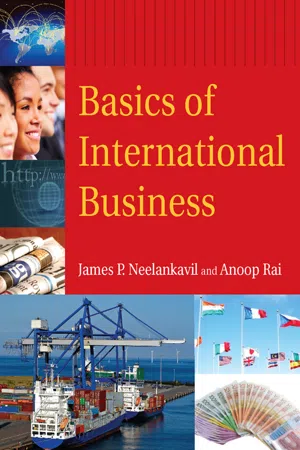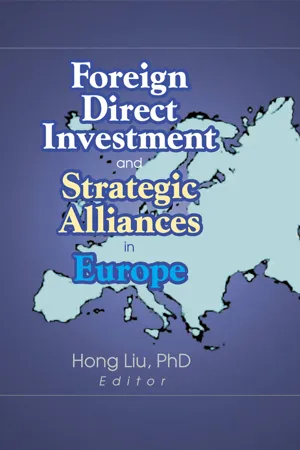Business
Market Entry
Market entry refers to the process of a company introducing its products or services into a new market. This can involve various strategies such as exporting, licensing, joint ventures, or establishing wholly-owned subsidiaries. Market entry decisions are crucial for businesses seeking to expand their customer base and increase their revenue streams.
Written by Perlego with AI-assistance
Related key terms
Related key terms
1 of 4
Related key terms
1 of 3
4 Key excerpts on "Market Entry"
- eBook - ePub
- James P. Neelankavil, Anoop Rai(Authors)
- 2014(Publication Date)
- Routledge(Publisher)
In deciding to go international, a company must choose an entry strategy to achieve its international expansion goals. Entry strategies set the stage for an international company’s success in its expansion into overseas markets. Choosing the right entry strategy saves money and time, provides strategic advantages, and lessens the risks associated with international operations. The choice of a particular entry strategy is most often a result of athorough analysis of the company’s strengths and weaknesses and a comprehensive external environment analysis that includes the market potential. Some key internal factors that are considered include a company’s core competencies and its risk threshold, or how much financial risk the company is willing to take. In entering a foreign market, a company can choose from a minimal investment option to one that requires a large investment. International companies can choose from four distinct entry strategies: exporting/importing, licensing/franchising, joint ventures, and wholly/fully owned subsidiaries. Licensing/franchising, joint ventures, and wholly owned subsidiaries require direct investments in the foreign country. Each strategy is designed for gaining entry into foreign markets under varying conditions. These entries are not necessarily unique to large international companies; small and medium-sized companies also use them.As mentioned earlier, the selection of an entry strategy is often dictated by both internal and external factors the company faces. The firm’s size, the number of products/services it offers, its financial position, its marketing expertise, and the number of countries the company operates in are some of the internal factors that may dictate its entry strategy. In the external environment, factors such as market size, potential growth of the market, regulatory environment, intensity of competition, knowledge of the market, and the host country’s economic and political conditions might all play a role in the choice of entry strategy.It is also possible that once a company selects a particular entry option, it might decide to shift into another mode based on internal and external changes. For example, a company that started out as an exporter might sometime in the future decide to enter into a joint venture agreement or even invest in a wholly owned subsidiary. Toyota Motors entered the U.S. market with exports of its vehicles from Japan; eventually it built manufacturing plants in the United States to serve the growing market it had captured. International companies have sometimes taken the reverse approach; that is, after starting out as a wholly owned subsidiary, a few have downsized their operations and used exports to cater to the needs of the market. For instance, after many years of operations in India, IBM left the country and returned as an exporter of its hardware and software. - eBook - ePub
International Marketing (RLE International Business)
Strategy and Management
- Colin Gilligan, Martin Hird(Authors)
- 2013(Publication Date)
- Routledge(Publisher)
Part two Market Entry Decisions and Approaches to International Marketing PlanningPassage contains an image
4 Market Entry Strategies
DOI: 10.4324/9780203077771-7For many companies, the most fundamental and far-reaching decisions in international marketing revolve around the question of the Market Entry strategies that are to be used and the patterns of distribution that are subsequently to be developed. There are a number of factors that account for the significance of these decisions and it is to these that we turn our attention within this chapter.Entering Foreign Markets
The question of how best to enter foreign markets is the first and in many ways the most fundamental to be faced by the marketer, since it is this choice that subsequently influences and shapes the whole of the international marketing programme. If, for example, the company opts for a distributor or licensee, its ability to influence pricing and promotion is likely to be limited. If, by way of contrast, it decides to opt for its own manufacturing subsidiaries, the degree of control that can be exerted will be far higher, although this in turn will be reflected both in the set-up and the direct operating costs.In essence, therefore, the Market Entry decision involves a balancing of costs, control and risk. With this in mind, the marketer needs to consider carefully the various distribution alternatives that are open to him and what he wants to achieve. Once a choice has been made, he is likely to find that he has entered into a long-term commitment that can only be changed with difficulty and at a high cost. Recognising this, the three major options with which he is faced are indirect exporting, direct exporting, and foreign manufacturing. These are shown schematically in Figure 4.1 - eBook - ePub
The Art of Going Global
A Practical Guide to a Firm's International Growth
- Olga E. Annushkina, Alberto Regazzo(Authors)
- 2020(Publication Date)
- Palgrave Macmillan(Publisher)
economic distance between the home and target markets will influence your internationalization strategy in two ways. Firstly, you will need to adapt your products and services to lower or higher levels of economic development in the target market to account for the different purchasing capacity of customers, whether these are businesses or end consumers. The decision as to how you do this could be aided by the input of a local partner, a potential source of knowledge about the local market. Secondly, your competitive advantage, in terms of cost leadership or superior technology, may not be relevant in markets with higher or lower levels of economic development to that of your own. Your choice of entry mode will strongly influence your firm’s ability to either transfer its competitive advantage to a new, economically different market, or to build a competitive advantage based on local resources.5.3.3 Why a Firm’s Strategy Matters When Decision on an Entry Mode
The decision about the firm’s strategy in terms of which and how many foreign markes are served, which business units and which business activities are located abroad, about resources dedicated to internationalization, about its organizational structure, along with decisions about the level of adaptation of its products and services will determine the level of commitment needed to each new foreign market.The first necessary step is to distinguish two broad types of foreign Market Entry decisions: investments into sales and distribution or into production or research and development activities, or both.In this sense, the extent to which your firm’s end product is service based (and the how tangible that service is) will also significantly influence your mode of foreign Market Entry.For industries that are ostensibly service based, such as telecoms, fast food, or traditional or digital retail chains, a decision to expand abroad means that almost all of the firm’s value chain activities will be transferred to the new market. This is also becoming the case for other industries, where the level of service content is increasing as fewer and fewer firms define themselves as purely “manufacturing”. This is seen as a way for firms to differentiate and to increase customers’ loyalty. - Hong Liu(Author)
- 2018(Publication Date)
- Routledge(Publisher)
Towards a Contingency View of Market Entry Strategies: Contextual and Strategic Factors Tamar AlmorSUMMARY. The model presented in this paper examines the relationship between contextual and strategic factors and foreign Market Entry strategies in the form of: (1) wholly-owned marketing subsidiaries, (2) international joint ventures, (3) international strategic alliances, (4) exports.Hypotheses are presented and tested on a sample of Israeli manufacturers who market their products in the European Union. Results show that each entry mode has a different contextual and strategic configuration, thus supporting the need for a contingency view. [Article copies available for a fee from The Haworth Document Delivery Service: 1-800-342-9678. E-mail address: <[email protected]> Website: < http://www.HaworthPress.com > © 2001 by The Haworth Press, Inc. All rights reserved.]KEYWORDS. Market Entry strategies, FDI, international strategic alliances, international joint ventures, export, contingency view of entry modesIntroduction
Research regarding choice of Market Entry mode has largely focused on contextual variables such as country of origin and industry (e.g., Almor & Hirsch, 1995; Braunerhjelm & Oxelheim, 1992; Chang and Rosenzweig, 1998; Nitsch, Beamish and Makino, 1996; Oxelheim & Gärtner, 1996), size (e.g., Agarwal & Ramashwami, 1992; Buckley and Casson, 1976; Calof, 1994) and ownership (e.g., Argarwal and Ramaswami, 1992; Kogut and Singh, 1988). Other researchers have studied strategic variables in relation to Market Entry strategies such as a firm’s strategy, knowledge transfer and its perception of the competitive environment (e.g., Anderson and Gatignon, 1986; Calof & Beamish, 1995; Caves and Mehra, 1986; Gatignon and Anderson, 1988; Kim and Hwang, 1992; Kogut and Singh, 1988; Kogut and Zander, 1993). The various studies show that contextual as well as strategic variables are related to choice of Market Entry strategies.
Index pages curate the most relevant extracts from our library of academic textbooks. They’ve been created using an in-house natural language model (NLM), each adding context and meaning to key research topics.
Explore more topic indexes
Explore more topic indexes
1 of 6
Explore more topic indexes
1 of 4



